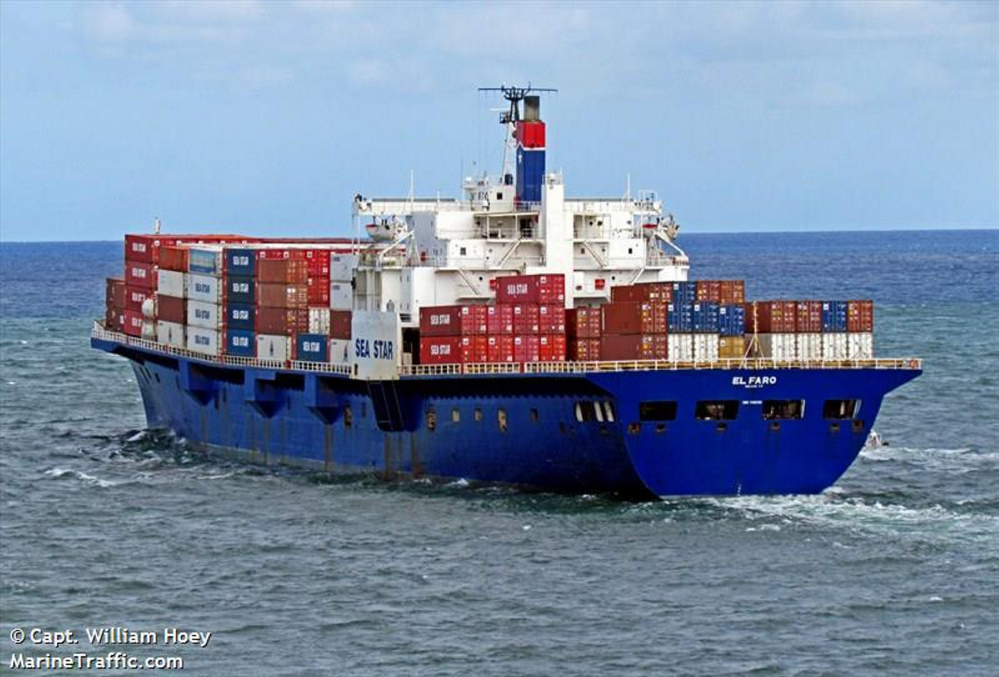MIAMI — At 15,000 feet deep, the wreck of the El Faro sits in one of the least explored places on earth, a lonely grave as deep as the Rocky Mountains are tall, with no light, crushing pressure, temperatures just above freezing and little life beyond microbes, giant worms and strange, tube-eyed fish.
Even the most advanced submarine can’t venture this deep.
In such daunting conditions, federal investigators have turned to a sophisticated unmanned submersible as they continue to search for clues to the cargo ship’s sinking off the Bahamas during Hurricane Joaquin. The remotely operated vehicle, or ROV, is equipped with high-definition cameras to survey the ship’s hull and robotic arms able to cut cables and grab important evidence, like the ship’s critical black box.
First developed by the Navy, the boxy ROV may be the best hope for unraveling the El Faro’s fateful voyage and determining exactly why it sank on Oct. 1.
“They’re very capable, but very complex to operate,” said Justin Manley, an MIT-trained ocean engineer who piloted the same cutting-edge ROV, called a CURV 21, for the National Oceanic and Atmospheric Administration when it mapped the Titanic, perhaps history’s most famous shipwreck, 12,500 feet down in the icy North Atlantic.
The El Faro apparently sank only minutes after its final distress call, killing all 33 crew members.
Among the crew were four Maine residents: Captain Michael Davidson of Windham, Danielle Randolph of Rockland, Michael Holland of Wilton and Dylan Meklin of Rockland. All four graduated from Maine Maritime Academy in Castine, as did as a fifth crew member, Mitchell Kuflik of Brooklyn, New York.
After sonar detected the El Faro resting upright on the ocean floor north of Crooked Island in the Bahamas, the U.S. Navy ship Apache deployed the deep-diving robot to document the condition of the ship and locate the black box, called a voyage data recorder. The NTSB has so far released little information about its findings, other than to report that the ROV has inspected the port and starboard sides of the vessel and that the bridge, which contains the critical recorder, is no longer attached to the ship.
Finding the recorder is critical because, in addition to navigation data, it contains audio that could let investigators, and families, hear what the crew said during the ship’s last moments. Efforts to track the data recorder’s “pinger” signal across a 260-square-mile search area have so far failed, and the batteries that powered it are designed to last only 30 days after it becomes activated by immersion.
There is also a possibility of recovering something that may bring some measure of comfort to families – bodies of the crew that went down with the ship.
“It’s a strange world of reality that has hit these families,” said John Moore, an attorney in Coral Gables, Florida, who is representing the families of two crew members. “They would like to have closure. I think recovering their loved ones is a step in that direction.”
RECOVERY OF BODIES UNLIKELY
But the chances of that happening are remote. NTSB spokesman Peter Knudson said investigators do not plan on trying to enter the vessel and search teams have not yet located the bridge of the ship, where the captain and a portion of the crew would have been stationed during the El Faro’s battle with Joaquin, a Category 4 Hurricane. Surveys of a large debris field have continued in hopes of locating that important part of the ship.
Capable of diving to 20,000 feet, the CURV 21 is the latest model of the cable-operated vehicle developed by the Navy decades ago. Fewer than 50 exist, Manley said. They are regularly employed by the offshore energy industry but also have increasingly been used to try to unravel the mysteries of deep sea wrecks, including the Malaysia Airlines Flight 370 that crashed in the Indian Ocean in March 2014 and a U.S. Air Force F-16 that plunged into the North Pacific six years ago after the pilot ejected.
Capable of withstanding the harsh conditions in the ocean’s Abyssopelagic zone – the abyss part comes from the Greek word for bottomless – the CURV 21 can be a bear to pilot. Manley compared it to standing atop the Empire State building and using a camera the size of a yo-yo, dangled from a string.
“It can be incredibly frustrating,” he said.
Investigators started by sweeping the outside of the ship, something called “mowing the lawn,” looking for clues about the hull’s condition when the El Faro sank.
Ships as big as the El Faro – at 790 feet, it is more than twice the length of a football field – often have airtight compartments. They are designed to float, even if water starts leaking into one or more compartments, Moore said.
ATTORNEY PLANS TO FIGHT RULING
In his final message from the ship, Davidson, the captain, reported that the ship had lost propulsion and a hatch, or scuttle, had blown open, allowing water to enter one compartment. Davidson, who knew he was approaching a worsening hurricane and told his bosses at Tote Maritime Puerto Rico that he planned to sail 65 miles south of the storm, likely would have secured all the hatches.
“In this case, you have a crew that is well-trained judging from their maritime backgrounds and licensing. All evidence points to the ship itself as having deficiencies,” said Gables attorney Moore, who plans to fight a ruling this week in Jacksonville federal court won by Tote to cap liability at about $15 million and set a December deadline for families to sue.
Investigators also may try to determine the condition of the ship’s life rafts or locate a life boat that remains missing. Both contain equipment to send distress calls.
WEATHER COULD HAMPER SEARCH
But if weather off the Bahamas worsens, the search efforts may slow.
At such depths, the crew piloting the ROV must account for shifting currents – different depths can have their own currents moving in various directions – as well as movement of the surface ship. Often a team of two to five people operates the craft with one person serving as pilot, another manning the arms and someone else overseeing navigation, said Manley, whose consulting firm Just Innovation deals with the emerging technology of underwater drones.
The CURV 21 also comes equipped with a rack of tools that can be attached to the robot arms and used for cutting or other tasks. The tools are strong enough to cut cables and wires, said Navy spokeswoman Colleen O’Rourke, but not doors or the ship’s hull.
As the ROV moves alongside the ship, and nearly three miles of cables loop and twist in the alternating currents, the pilot also needs to be careful not to create another wreck.
“The hardest part is you have this robot that is thousands and thousands of feet deep and connected by a cable to the ship and there’s current between you and the bottom. There’s also current,” on the surface, Manley said. “It’s this delicate ballet of controlling the ship, controlling the robot and controlling the winch.”
Send questions/comments to the editors.




Success. Please wait for the page to reload. If the page does not reload within 5 seconds, please refresh the page.
Enter your email and password to access comments.
Hi, to comment on stories you must . This profile is in addition to your subscription and website login.
Already have a commenting profile? .
Invalid username/password.
Please check your email to confirm and complete your registration.
Only subscribers are eligible to post comments. Please subscribe or login first for digital access. Here’s why.
Use the form below to reset your password. When you've submitted your account email, we will send an email with a reset code.